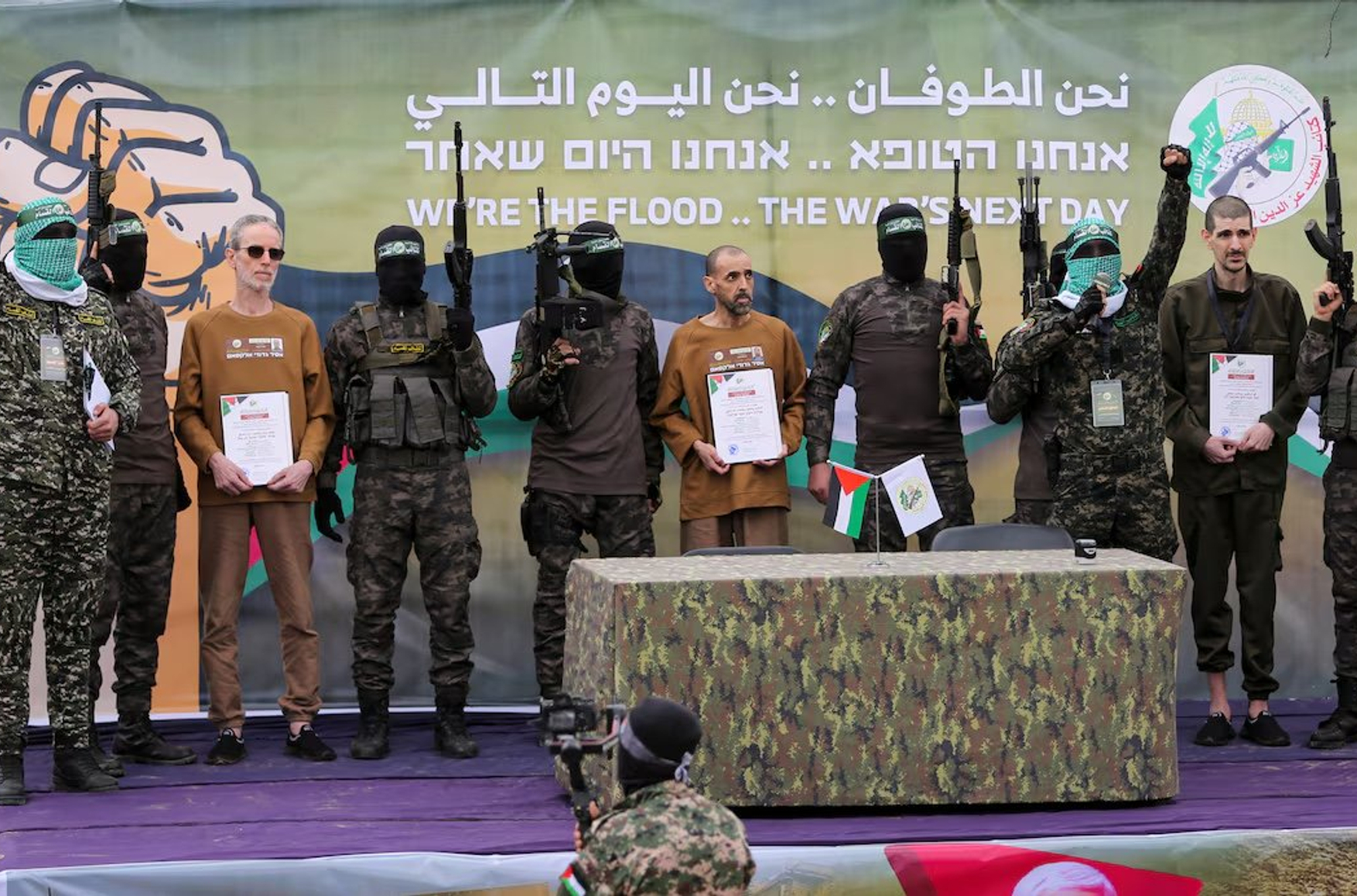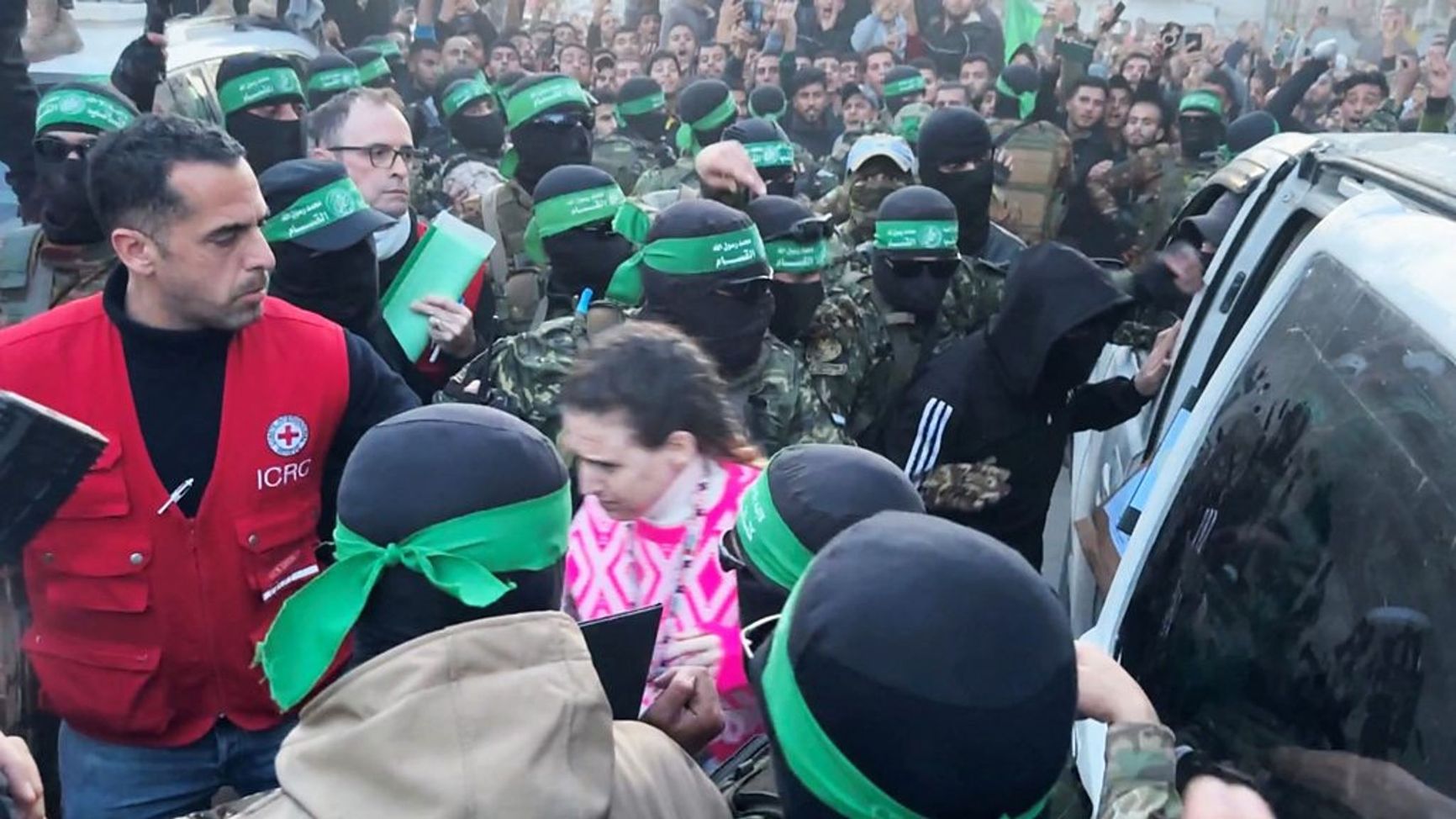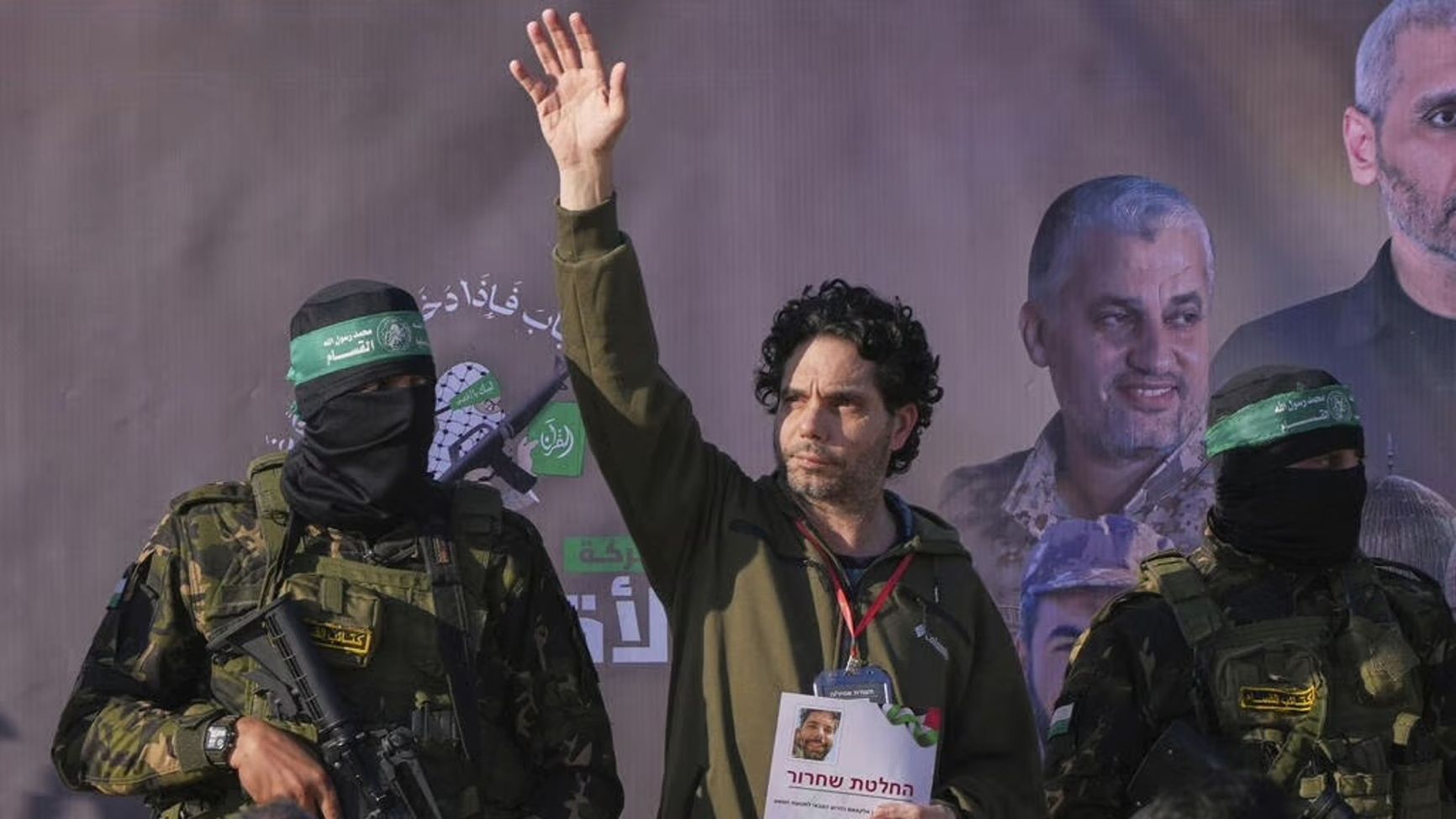

Israeli Prime Minister Benjamin Netanyahu has vowed to resume military operations in the Gaza Strip if Hamas militants fail to release three Israeli hostages by the agreed-upon deadline of noon on Feb. 15. The appearance of Eli Sharabi, Ohad Ben-Ami, and Or Levy, who were freed on Feb. 8, already profoundly shocked Israel. Emaciated and drastically underweight, they bore a striking resemblance to concentration camp survivors. Upon their release from Gaza, the men were immediately transported to Israeli hospitals, where doctors assessed their health as “poor.” They were diagnosed with acute malnutrition, heart problems, infections, and various injuries. While not all of the released hostages are ready to disclose the details of their captivity, accounts from them and their relatives reveal that hostages in Gaza are held in tunnels devoid of daylight — they are intentionally starved, tortured, and subjected to sexual violence. Throughout their sixteen months in captivity, they received no visits from the Red Cross or any other humanitarian organizations.
Content
“The terrorists laughed while looking at the open wound”
“The smell coming from us was the worst thing you can imagine”
“He put a gun to my head and started kissing me”
“The doctor looked at me and said, 'You are not going to go home alive'”
Ayelet Hakim, the sister-in-law of Ohad Ben-Ami, one of the Israelis released from Hamas captivity on Feb. 8, watched live footage of him being led onto a makeshift stage in Gaza for transfer to the Red Cross. Initially, she did not recognize the man on the screen. It was difficult to identify the former Ben-Ami in the gaunt figure who could barely stand. “Everyone around me was shouting, 'Look, it's Ohad!' But no matter how I looked I couldn't recognize him,” Ayelet admitted in an interview with an Israeli radio station.

Eli Sharabi (52), Or Levy (34), and Ohad Ben-Ami (56) were released on Feb. 8. Levy's wife was killed during the Hamas attack. Sharabi's wife and daughters also perished, and his brother died in captivity. Hatem Khaled/Reuters
The sight of the three Israelis, who after 16 months of captivity resembled concentration camp survivors, sent shockwaves throughout the nation. Unlike hostages released earlier — who appeared to be in better shape after reportedly receiving extra food and, in some instances, stimulants or other drugs to improve their physical appearance before being returned — these men were shockingly frail. During the staged release “ceremony,” they waved to the assembled crowd and even smiled at the armed, masked militants, an act seemingly intended to portray that their treatment by Hamas had been humane. However, the harrowing testimonies of the released hostages — and the testimonies of their families and medical professionals — reveal a starkly different reality.
“The terrorists laughed while looking at the open wound”
24-year-old Romy Gonen returned to Israel on Jan. 19 as one of three Israeli women released on the first day of the ceasefire. Wounded in the arm on Oct. 7, 2023, she suffered from agonizing pain throughout her 15 months in captivity.
“They didn't give her any pills or anything. An open wound...she hurt all the time, until the day she was released,” Romy Gonen’s mother, Merav Leshem-Gonen, told the Israeli publication Ynet. According to Leshem-Gonen, when her daughter tried to disinfect the wound herself, the terrorists stood nearby and laughed.
“We will never know everything they had to go through,” says the hostage's mother. Psychologists recommend that relatives not rush into questioning, but much is clear without words.

Doron Steinbrecher surrounded by Hamas militants at the moment of her release. She was released along with Romy Gonen and Emily Damari on the first day of the deal's implementation.
Gonen, who at times was held in Hamas tunnels and in the homes of Gaza residents, lost 10 kilograms and suffered severe muscle loss. During captivity, she became so accustomed to starvation that she did not ask for food until two weeks after her release.
During captivity, Gonen became so accustomed to starvation that she did not ask for food until two weeks after her release
She could only occasionally manage a “shower” with a glass of water. Deprived of sunlight, her skin turned gray. Gonen's right hand remains nonfunctional, requiring a complex operation and a challenging rehabilitation process — without any guarantee of full recovery.
“The smell coming from us was the worst thing you can imagine”
Keith Siegel, 65, released on Feb. 1, was kept in a cage and starved. At a press conference at Ichilov Hospital, where he was taken from Gaza, his daughter Shir described his conditions as “inhuman”: “He barely saw daylight, went hungry for long periods, and lost a significant amount of weight. He was isolated for a long time and at times lost hope of ever returning home.”
Siegel's wife, Aviva, was also kidnapped on October 7 and returned to Israel in November 2023. In an interview with the AP after her release, she said: “Hostages were chained, tortured, starved, beaten up into pieces. I saw that in front of my eyes.” The terrorists dragged the 63-year-old woman by her hair and kicked her into a car when moving her from place to place.
At first, she and her husband were held in a Hamas member’s house, then in a tunnel with other abductees. Seven people were crammed into a room no larger than “three yoga mats”:
“They used to starve us while they ate in front of us and not bring us water for hours and days. I had an infection in my stomach. I was dehydrated. We had to beg — beg — for water. Beg and beg for food.”
During her 50 days in captivity, Siegel was able to brush her teeth only four times and bathe just as often — using seawater.
“It's disgusting. We were smelly, dirty. The smell coming from us is the worst thing you can imagine,” Aviva Siegel recalls.
“He put a gun to my head and started kissing me”
Noa Argamani, who was released as a result of a special operation by the IDF in June last year, said that the female hostages, who were held in the apartments of Palestinians connected with Hamas, were used as servants — they were forced to clean and cook, and they were not allowed to eat. This was also mentioned by the female IDF soldiers who were released at the end of January.
This is far from the worst that Israeli hostages endured in captivity. A report by the Israeli Ministry of Health on the condition of released hostages, presented to the UN in late December, stated:
“Women, men, and children who returned from captivity reported severe physical violence — they were beaten all over their bodies, some had hair pulled out, and in some cases were burned and branded. Others, including children, were subjected to sexual assaults or forced to undress.”
Amit Susuna, released in November 2023, described being raped in captivity in an interview with The New York Times. She was kept chained by her ankle in a child’s bedroom inside someone’s house. A terrorist named Mohammed, who was guarding her, forced her into sex at gunpoint. Later, other militants brutally tortured her, tying her between beds and beating her with a stick. Convinced she was an Israeli army officer, they demanded a confession.
Militants beat the hostage with a stick because they were convinced she was an Israeli army officer
18-year-old Agam Goldstein, who was also released as part of the first exchange deal in November 2023, testified about harassment and sexualized violence against Israeli hostages:
“One hostage told me how the terrorist guarding her went into the bathroom with her, put a gun to her head, and started kissing her. She cried... The terrorist took off all her clothes and started touching her body with one hand while holding the weapon to her head with the other... I asked her, 'Did you do what he asked?' And she replied, 'What do you think? I had no choice.'”
“The fear of getting raped and vulnerability of this kind could never get off your mind,” said Yarden Roman Gat, who spent 54 days in Hamas captivity. “As long as you're there, you're hopeless. You have no protection, you cannot object to anything. It could cost you your life.”

Israeli female soldiers in the first days of captivity by Hamas
“They told my sister what to do and controlled her every minute,” Yarden's brother recalled in an interview. “You are completely dependent on the will of three armed terrorists who are holding you alone in a house. According to my sister, captivity is when they force you to stop being human.”
“The doctor looked at me and said, 'You are not going to go home alive'”
“It’s hell, make no mistake,” the cousin of Ofer Calderon, who was released in early February, describes what he experienced in Gaza. According to relatives of the former hostage, he was held in underground tunnels, in a cage, not given normal food, and kept in the dark about the fate of his family.

Ofer Calderon after being released
Or Levy and Eli Sharabi, who were released on Feb. 8, were also held in the tunnels. From them, the mother of Alon Ohel, one of the hostages who was not included in the list of those being released in the first stage of the current deal, learned that her son is still alive. Ohel is severely wounded, does not receive any treatment, and is also being held underground.
In addition to tunnels and private homes, hostages are also held in administrative buildings. For example, former hostage Emily Damari spent some time in the premises of UNRWA — the United Nations Relief and Works Agency for Palestine Refugees. During the attack of October 7th, she was wounded and lost two fingers. The terrorists refused to provide her with medication.
According to the Israeli Ministry of Health report, “terrorists tortured the wounded by performing painful procedures without anesthesia.” Mia Schem, who was released in November 2023, also spoke about this. According to her, the surgeon who operated on her without anesthesia in a Gaza hospital, looking her in the eye, said: “You are not going to go home alive.”
Hamas hostages are subjected not only to physical but also psychological torture. The terrorists forced both adults and children to watch videos taken on October 7th, in which militants torture and kill Israelis.
Terrorists forced both adults and children to watch videos taken on October 7th, in which militants torture and kill Israelis
Children were forbidden from speaking loudly under threat of death. Nine-year-old Emily Hand, who spent 50 days in captivity, spoke only in a whisper for some time after returning home.
In the 16 months since the massive Hamas terrorist attack, Red Cross representatives and other humanitarian organizations have never been allowed to visit the hostages. In January 2024, Hamas and Israel, mediated by Qatar and France, agreed to deliver medication to the prisoners in exchange for additional humanitarian aid for Gaza residents. However, Israel never received proof that the medicine reached those for whom it was intended.
After the release of the most recent group of hostages, the Hostage Families Headquarters issued a statement saying that the shocking testimonies of those freed left no room for doubt: “Time is critical, and all hostages must be rescued immediately.” 1,700 Israeli doctors signed an appeal to their colleagues worldwide, stating that the condition of the released hostages indicates a life-threatening situation for all those still held in Gaza.
Whether the agreements between Israel and Hamas will hold remains unclear. The existing deal calls for the release of 17 more hostages from the 76 still held in Gaza in the coming weeks. Negotiations on the second phase were set to begin within days. However, on Feb. 10, Hamas announced it was suspending the deal, citing alleged Israeli ceasefire violations. In response, Israeli Prime Minister Benjamin Netanyahu warned that military operations in Gaza would resume if the hostages were not released by noon on Feb. 15. U.S. President Donald Trump, meanwhile, warned that if the hostage release falls through, “all hell” will break loose in Gaza.